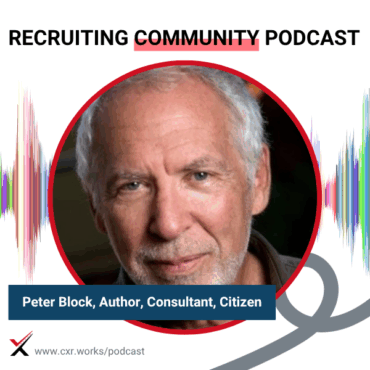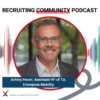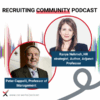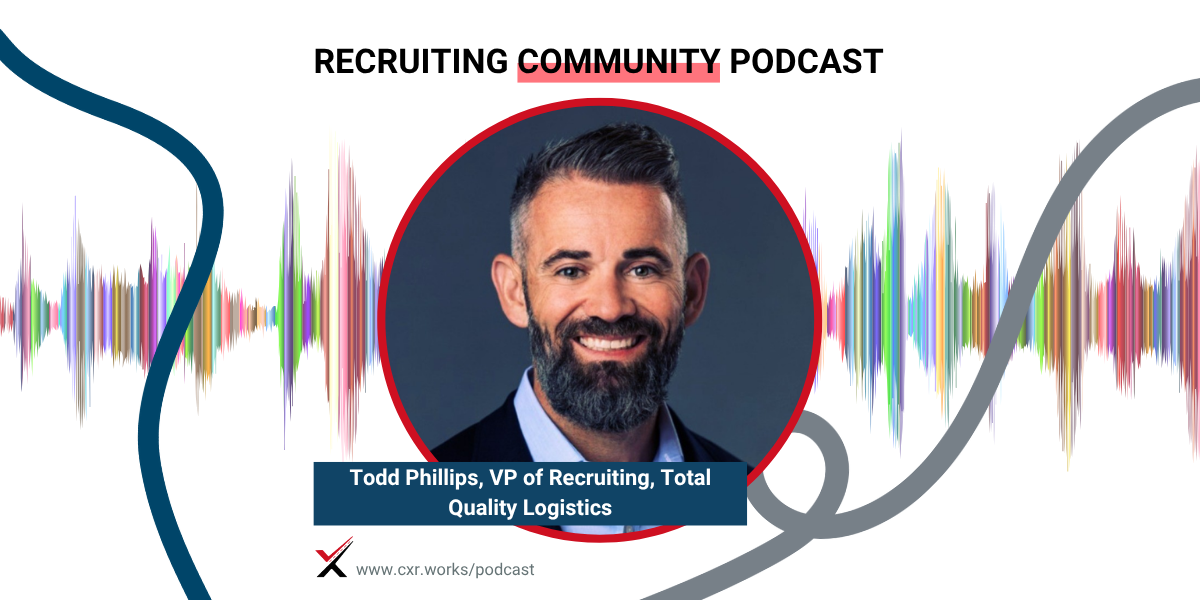
The Value of Community
What if recruiting wasn’t about “acquisition,” but invitation? Peter Block joins CXR to rethink how we build culture—through conversation, not compliance.
 play_arrow
play_arrow
 play_arrow
play_arrow
Transforming High-Volume Hiring at 7-Eleven Cami Grace
 play_arrow
play_arrow
From Early Childhood to Talent Tech: Allyn Bailey’s Career Crossroads Cami Grace
 play_arrow
play_arrow
In Praise of the Office Cami Grace

Episode Overview:
In this episode, we delve into the transformative talent development and retention strategies implemented at TQL (Total Quality Logistics). The discussion centers on pioneering initiatives introduced by our guest, Todd Phillips, aimed at elevating the quality of hiring processes and strengthening the retention of key talent within the organization.
Key Topics Covered:
Guest Speaker Information:
Todd Phillips comes with a formidable background combining military leadership and vast experience in recruitment. Currently leading strategic talent initiatives at TQL, Todd’s expertise provides actionable insights for organizations seeking to revamp their talent acquisition and retention frameworks.
Closing Notes:
As we wrap up this episode, we’re reminded of the critical importance of steadfast commitment to long-term goals in the realm of talent management. The conversation with Todd Phillips not only serves as a testament to the robust potential of well-thought-out development programs but also underscores the significance of persistence and clear communication in achieving organizational success in talent management.
Title:
Improving Hiring Outcomes
Featured Guests:
Todd Phillips, Director of Talent Acquisition, Total Quality Logistics (TQL)
Hosts:
Chris Hoyt, President, CareerXroads
Gerry Crispin, Principal and Co-founder, CareerXroads
Episode Overview:
In this episode, Todd Phillips of TQL shares two key initiatives aimed at improving recruiting outcomes: a formal hiring manager interview training program and a strategic focus on recruiter retention. He details how TQL designed its certification model, built mentorship into recruiting onboarding, and aligned leadership around a long-term vision for hiring success.
Key Topics:
In-house hiring manager certification program
Four-phase interview training and audit structure
Expansion of recruiter onboarding and mentor support
Metrics for success: recruiter retention and hires per recruiter
Balancing short-term results with long-term TA strategy
Building internal alignment with scorecards and visual campaigns
Advice for TA leaders launching structured initiatives
Notable Quotes:
“Turnover is inefficiency in the hiring process.” — Todd Phillips
“We want to build a more experienced, tenured, and productive recruiting team.” — Todd Phillips
“Take the long view—measure success over the year, not the month.” — Todd Phillips
“If we improve retention and hires per recruiter, a lot of problems solve themselves.” — Todd Phillips
“Stay focused, stay consistent—stay the course.” — Todd Phillips
Takeaways:
Long-term talent acquisition success depends on foundational training, mentoring, and aligned leadership. TQL’s dual investments in interview training and recruiter development are already yielding stronger retention and performance. TA leaders looking to elevate results should focus on fundamentals, measure deliberately, and communicate their vision across the organization.
Want more conversations like this?
Subscribe to the CXR podcast and explore how top talent leaders are shaping the future of recruiting. Learn more about the CareerXroads community at cxr.works.
Chris Hoyt: I feel like there was a show in the ’80s where the heroes would always say, “What’s the worst that could happen?” Does that ring a bell? You’d hear it, and then all hell would break loose.
Gerry Crispin: Yeah, something like that. And then everything goes crazy.
Todd Phillips: Sounds familiar, but I can’t pinpoint it for sure.
Chris Hoyt: So, we’re having some technical issues. I hate it when podcasts complain about tech stuff, but here we are. A little bit of lag—this is our second show in a row with it. We may need to figure out what’s going on. Jerry, you think it’s my location?
Gerry Crispin: Yeah, and the world’s shifted. Everybody lives on the internet now. Think of it as extra traffic—it’s crowded.
Chris Hoyt: All right, I can take that. So, I guess we can jump right in. Todd, are you ready to go?
Todd Phillips: Yes, sir.
Chris Hoyt: Okay, let’s do it.
Announcer: Welcome to the CXR channel, our premier podcast for talent acquisition and talent management. Listen in as the CXR community discusses a wide range of topics focused on attracting, engaging, and retaining the best talent. We’re glad you’re here.
Chris Hoyt: All right, welcome to the Recruiting Community Podcast—your weekly insights and updates in the form of a conversation. Today’s topic is improving recruiting outcomes, and I’m excited about it.
I’m Pinky, and my co-host is The Brain. Welcome, Brain.
Gerry Crispin: Thank you, Pinky.
Chris Hoyt: We’ve had some people ask about our format—if we follow a script, how much work goes into this—and I think it’s worth calling out for our five listeners that this is just a conversation. We don’t do recaps, we don’t do editing. That’s why we love the livestream piece—it’s the pressure of live TV.
Gerry Crispin: I love that. There’s something authentic about it. There’s usually a nugget or two in there. That’s really what it’s all about.
Chris Hoyt: They’re quick—20 minutes, easy to consume. For those who’ve joined us live, we’re streaming on YouTube, Facebook, and LinkedIn. We’ve also created Blue Sky accounts—no streaming there yet, but we’re keeping an eye on it.
You can always go to cxr.works/podcast to see past and future episodes. Quick reminder: this is a labor of love. We don’t charge guests to be on the show. If they’re here, it’s because they’re doing something cool and we want to shine a light on it.
And if you’re on LinkedIn, drop a comment. Say hello, share your LinkedIn profile, ask questions—if we catch them during the show, we’ll throw them up on the screen. Jerry, anything else before we bring in our guest?
Gerry Crispin: Nope—let’s do it.
Chris Hoyt: All right, Todd, welcome in from the green room. How are you?
Todd Phillips: Great. Thanks for having me.
Chris Hoyt: For those who haven’t met you or worked with you, give us a quick intro. Who is Todd Phillips at TQL, and why should folks stay tuned?
Todd Phillips: Sure. I’ve been in recruiting for over 19 years. My background is pretty unique—I started in the Army, spent nine years there, I’m a combat veteran and Ranger School graduate. I got recruited into the recruiting world—started in agency with Orion Talent. I ran recruiting operations nationally for them—about 600+ clients across logistics, supply chain, manufacturing, sales, and tech.
I did some consulting, and now I’m eight months into my role at Total Quality Logistics. We’re the second largest freight broker in North America, hiring about 5,000 people a year. So, I’ve seen both agency and internal sides and now I’m getting my feet under me here.
Chris Hoyt: You’ve got a lot on your plate. We promoted this episode saying you had some big initiatives at TQL. Can you give us an overview?
Todd Phillips: The first major initiative is hiring manager interview training. It’s something I always wished for in agency work—that hiring managers were trained to interview. So we’re giving everyone who interviews a strong foundation. The focus is on under-two-year leaders, but even tenured folks go through it for sharpening their skills. There’s a certification and sign-off process.
The second major initiative is recruiter retention and development. We’re focused on building a more experienced, tenured, and productive recruiting team, and we’ve got some sub-initiatives tied to that.
Chris Hoyt: Let’s talk about that hiring manager training. Are we talking formal certifications? Is this in-house or outsourced?
Todd Phillips: It’s built in-house by our learning and development team in collaboration with recruiting. It’s a four-phase program: overview, interview workshop, peer reviews of recorded interviews, and certification. New interviewers are paired with experienced ones until they’re certified.
We also have an audit process with department-specific KPIs. If something’s off, we go back and retrain.
Gerry Crispin: That audit process is key. You can teach skills, but people revert. Continuous review is how you ensure long-term impact. Sounds solid.
Todd Phillips: Absolutely. We’re about 50% through rollout. Sales is mostly in phase three. Sales support is in phase one.
Chris Hoyt: What inspired the team to focus on these two big strategies?
Todd Phillips: It really came down to turnover. Turnover is inefficiency in the hiring process. We were growing aggressively—adding leadership and recruiters quickly. So, we needed to ensure interviewers had a solid foundation and our recruiters were supported and retained.
We expanded recruiter training from two to eight weeks, assigned mentors, added more leadership layers for coaching, boosted pay at the entry level, and focused on hiring high-quality talent. If we retain them, they become more productive and make better hires. Then trained hiring managers are ready to receive those hires. It’s a full-circle strategy.
Chris Hoyt: Are you seeing any early trends?
Todd Phillips: We’ve already seen a 5% increase in recruiting team retention within a few months. We review this monthly—especially the under-one-year cohort, because that’s where we want more stability and growth.
Chris Hoyt: It can’t all be smooth sailing. Any challenges you’ve run into?
Todd Phillips: The biggest challenge was not having enough mentors. We prioritized our recruiter-in-training roles for mentorship. Our experienced hires go through a hybrid program but not the full mentorship path until we grow our mentor bench.
Chris Hoyt: We talk about mentoring a lot. The matching process is tricky. How do you pair mentors and mentees?
Todd Phillips: It’s done by the managers—they know their people. We consider personality and experience. Mentors are prepped with expectations and paired after a Q&A with leadership. It’s formal, but we also encourage initiative—recruiters can shadow others, ask questions, raise their hand.
Gerry Crispin: I love that. Internal programs benefit from structure, but people also need to be empowered to seek knowledge organically.
Todd Phillips: Exactly. We want everyone helping everyone. Shadowing, asking questions, learning from peers—it’s all encouraged.
Chris Hoyt: What metrics are you using to gauge success?
Todd Phillips: Two key metrics: retention and hires per recruiter. We track both monthly and year-over-year. If we can improve those two, a lot of other problems solve themselves.
Chris Hoyt: If I’m listening in and want to build something similar, what advice would you offer?
Todd Phillips: Be deliberate. Don’t pivot too fast if something doesn’t go perfectly. Take the long view—measure success over the year, not the month. Communicate your vision across the team and leadership. Show how it ties together and why it matters.
We’ve built visuals, campaign posters, and a scorecard we review monthly. It keeps everyone aligned and focused.
Chris Hoyt: Love that. Okay, final question: if you wrote a book about this journey, what would the title be?
Todd Phillips: Stay the Course. Because needle movers take time. It’s easy to chase shiny objects, but the fundamentals—blocking and tackling—matter. Stay focused, stay consistent.
Chris Hoyt: Who gets the first signed copy?
Todd Phillips: My mom. Gotta show her I did it—“Hey Mom, I wrote a book!”
Chris Hoyt: I love that. Well, Todd, thank you so much. I know you’re busy, and we really appreciate you taking the time. Can’t wait to hear more about the outcomes. I know the CXR community will want a peek at that dashboard.
Todd Phillips: Happy to share. Thanks again!
Chris Hoyt: That’s it for us. We’ll see everybody next week, same bat time, same bat channel.
Announcer: Thanks for listening to the CXR channel. Please subscribe to CXR on your favorite podcast resource, and leave us a review while you’re at it. Learn more about CXR at our website, cxr.works, facebook.com/careercrossroads, and twitter.com/careercrossroads. We’ll catch you next time.
Tagged as: Candidate Experience, Podcast, TA strategy, Talent Acquisition, Hiring.
Chris Hoyt is the President of CareerXroads, a global peer community for talent acquisition leaders driving strategic change. With decades of experience leading recruiting innovation at Fortune 500 companies, Chris now advises enterprise TA teams on tech, process, and leadership. He’s a frequent speaker at conferences like SHRM, HR Tech, LinkedIn, and UNLEASH, and he’s known for pushing conversations beyond buzzwords to get to what really works in hiring. Through CXR, he connects top TA professionals to solve real problems, challenge norms, and shape the future of recruiting.

What if recruiting wasn’t about “acquisition,” but invitation? Peter Block joins CXR to rethink how we build culture—through conversation, not compliance.